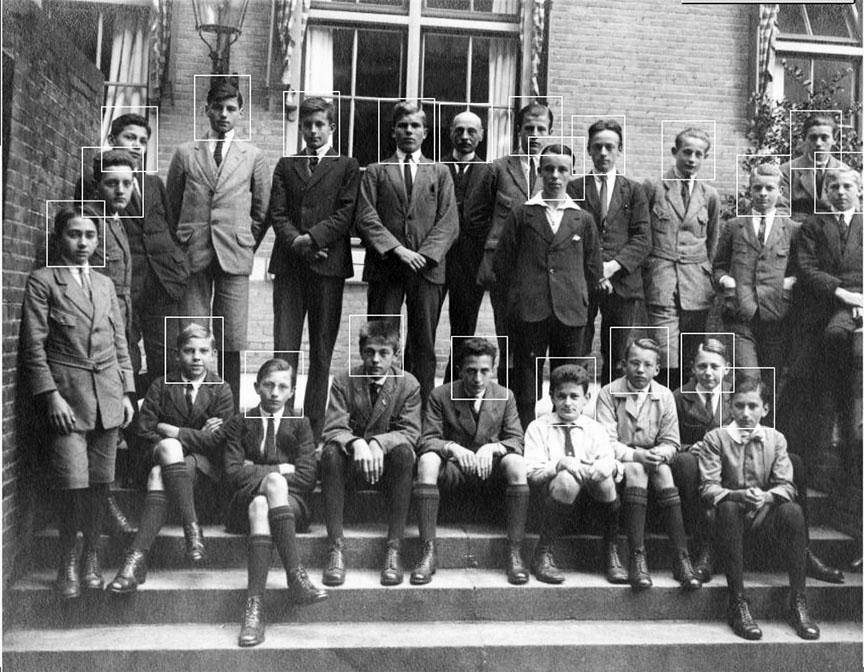
Individual Dutch Schools: Lyceum Thorbecke

Figure 1.-- This is a secondary school class of 16-year old boys from one of the most respected schools in the Netherlands--the Lyceum Thorbecke. The school was located in the Hague. The class portrait was taken during the 1920-21 school year. The school is an elite Lyceum, meaning a selective secondry school. The Lyceum was a public school, but one in which the students had to meet high standards. The boys are somewhat variously dressed reflecting the fact that European boys after World War I were gradually making a transition from knee pants and long stockings to short pants and knee pants. Knee socks were becoming more popular, but long stockings continued to be worn seasonally.
|
|
This is a secondary school class of 16-year old boys from one of the most respected schools in the Netherlands--the Lyceum Thorbecke. The school was named after the Dutch statesman Johan Rudolf Thorbecke (1798-1872), one of the leading liberal politicians in the Netherlands. The school was located in the Hague. The class portrait was taken during the 1920-21 school year. The school is an elite Lyceum, meaning a selective secondry school. The Lyceum was a public school, but one in which the students had to meet high standards. The boys are somewhat variously dressed reflecting the fact that European boys after World War I were gradually making a transition from knee pants and long stockings to short pants and knee pants. The Dutch weer able to remain neutral during the War, but were affcted by the poweful trends affecting Europe after the War.
Knee socks were becoming more popular, but long stockings continued to be worn seasonally. This transition varied from country to county, by the 1930s we mostly see Dutch boys wearing knee socks. Most of the boys seem to be wearing suits with short trousers and either black long stockings or knee socks. Some of the lads are in long trousers. It probably depended on the parents as to whether their sons were old enough to wear long trousers. There are more short trousers, however,
than long trousers, so the boys in shorts probably wouldn't have felt any inferiority. Most of the boys seem to have on formal shirts with neckties, but one boy has an open-collar shirt that spreads over his lapels, a sports or Shiller collar which was becoming a popular style. The squares around the faces are for purposes of identifying the boys,
and their names are available on the website if anyone is interested.
Transcribing them would be a bit of trouble since the frames aren't
numbered and can only be identified by matching enlargements of the
protraits individually. There doesn't seem to be any particular point
in supplying the names, but the website might be helpful to interested Dutch readers.
HBC

Navigate the Boys' Historical Clothing Belgian pages
[Return to the Main individual Dutch school page]
[Return to the Main Dutch page]
[Dutch art]
[Dutch choirs]
[Dutch movies]
[Dutch postcards]
[Dutch royalty]
[Dutch school smocks]
[Dutch youth groups]
Related Chronolgy Pages in the Boys' Historical Web Site
[Main Chronology Page]
[The 1880s]
[The 1930s]
[The 1940s]
[The 1950s]
[The 1960s]
[The 1970s]
[The 1980s]
Related Style Pages in the Boys' Historical Web Site
[Smocks]
[Berets]
[Long pants suits]
[Shortpants suits]
[Socks]
[Eton suits]
[Jacket and trousers]
[Blazer]
[School sandals]
Navigate the Boys' Historical Clothing School Uniform Pages
[Return to the Main European school information page]
[Australia]
[Belgium]
[England]
[France]
[Germany]
[Ireland]
[Italy]
[Japan]
[Netherlands]
[New Zealand]
[Scotland]
[United States]
Navigate the Boys' Historical Clothing Web Page
[Introduction]
[Activities]
[Biographies]
[Chronology]
[Clothing styles]
[Countries]
[Bibliographies]
[Contributions]
[FAQs]
[Dutch glossaries]
[Images]
[Links]
[Registration]
[Boys' Clothing Home]
Created: 4:14 PM 5/31/2012
Last updated: 4:14 PM 5/31/2012




